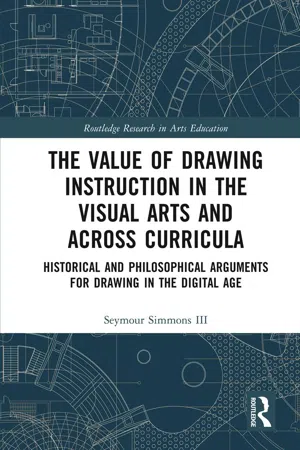
The Value of Drawing Instruction in the Visual Arts and Across Curricula
Historical and Philosophical Arguments for Drawing in the Digital Age
- 308 pages
- English
- PDF
- Available on iOS & Android
The Value of Drawing Instruction in the Visual Arts and Across Curricula
Historical and Philosophical Arguments for Drawing in the Digital Age
About This Book
By applying philosophical and historical perspectives to drawing instruction, this volume demonstrates how diverse teaching methods contribute to cognitive and holistic development applicable within and beyond the visual arts.
Offering a new perspective on the art and science of drawing, this text reveals the often-unrecognized benefits that drawing can have on the human mind, and thus argues for the importance of drawing instruction despite, and even due to contemporary digitalization. Given the predominance of visual information and digital media, visual thinking in and through drawing may be an essential skill for the future. As such, the book counters recent declines in drawing instruction to propose five Paradigms for teaching drawing – as design, as seeing, as experience and experiment, as expression, and as a visual language – with exemplary curricula for pre-K12 art and general education, pre-professional programs across the visual arts, and continuing education. With the aid of instructional examples, this volume dispels the misconception of drawing as a talent reserved for the artistically gifted and posits it as a teachable skill that can be learned by all.
This text will be of primary interest to researchers, scholars, and doctoral students with interests in drawing theory and practice, cognition in the arts, positive psychology, creativity theory, as well as the philosophy and history of arts education. Aligning with contemporary trends such as Design Thinking, STEAM, and Graphicacy, the text will also have appeal to visual arts educators at all levels, and other educators involved in arts integration.
Frequently asked questions
Information
Table of contents
- Cover
- Half Title
- Series Page
- Title Page
- Copyright Page
- Dedication
- Contents
- Figures
- Acknowledgments
- Preface
- In Conclusion
- 1. Introduction: Making the Case for Learning to Draw in Changing Times
- 2. Beginnings: Drawing as an Innate Human Capacity and a Matter of the Mind
- 3. What's in a Name?: The Uses of Philosophy in Addressing Drawing Education
- 4. Drawing by Design: Connecting Drawing and Design through Mathematics
- 5. Drawing as Seeing: Observational Drawing in Art, Science, and Medicine
- 6. Drawing as Experience and Experiment: Creativity in Art and Experimental Science
- 7. Drawing as Expression: Self-Knowledge and Societal Concerns
- 8. Languages of Drawing: Semiotics and the Search for Fundamentals
- 9. Toward a Comprehensive 21st Century Philosophy of Drawing Education
- Postscript
- References
- Index